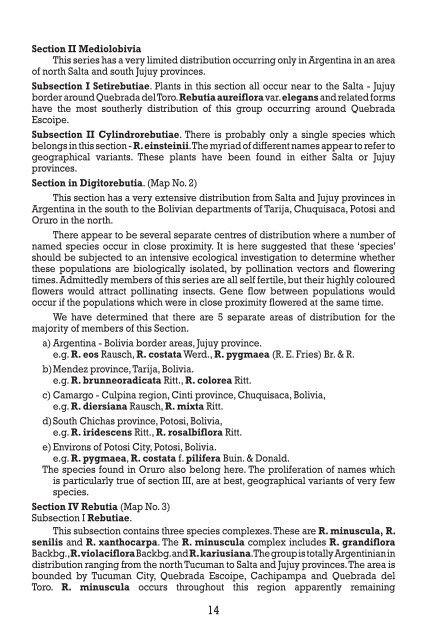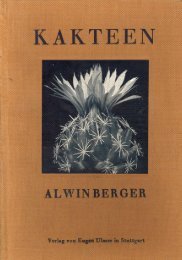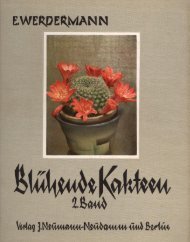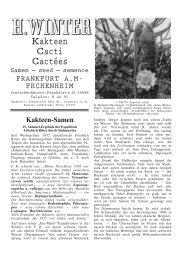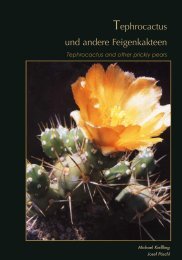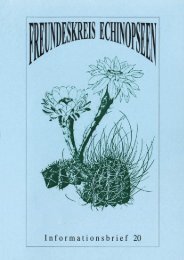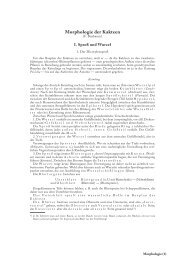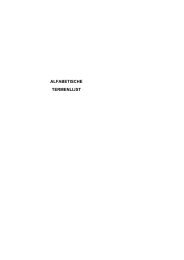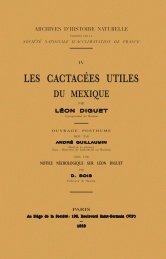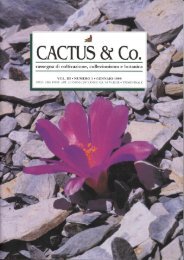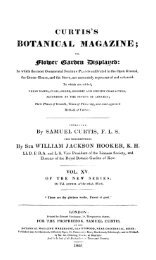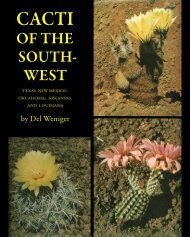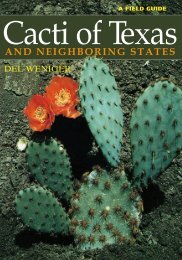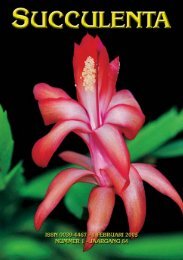the genus rebutia 1895—1981 - Free
the genus rebutia 1895—1981 - Free
the genus rebutia 1895—1981 - Free
Create successful ePaper yourself
Turn your PDF publications into a flip-book with our unique Google optimized e-Paper software.
Section II Mediolobivia<br />
This series has a very limited distribution occurring only in Argentina in an area<br />
of north Salta and south Jujuy provinces.<br />
Subsection I Seti<strong>rebutia</strong>e. Plants in this section all occur near to <strong>the</strong> Salta - Jujuy<br />
border around Quebrada del Toro. Rebutia aureiflora var. elegans and related forms<br />
have <strong>the</strong> most sou<strong>the</strong>rly distribution of this group occurring around Quebrada<br />
Escoipe.<br />
Subsection II Cylindro<strong>rebutia</strong>e. There is probably only a single species which<br />
belongs in this section - R. einsteinii. The myriad of different names appear to refer to<br />
geographical variants. These plants have been found in ei<strong>the</strong>r Salta or Jujuy<br />
provinces.<br />
Section in Digito<strong>rebutia</strong>. (Map No. 2)<br />
This section has a very extensive distribution from Salta and Jujuy provinces in<br />
Argentina in <strong>the</strong> south to <strong>the</strong> Bolivian departments of Tarija, Chuquisaca, Potosi and<br />
Oruro in <strong>the</strong> north.<br />
There appear to be several separate centres of distribution where a number of<br />
named species occur in close proximity. It is here suggested that <strong>the</strong>se ‘species’<br />
should be subjected to an intensive ecological investigation to determine whe<strong>the</strong>r<br />
<strong>the</strong>se populations are biologically isolated, by pollination vectors and flowering<br />
times. Admittedly members of this series are all self fertile, but <strong>the</strong>ir highly coloured<br />
flowers would attract pollinating insects. Gene flow between populations would<br />
occur if <strong>the</strong> populations which were in close proximity flowered at <strong>the</strong> same time.<br />
We have determined that <strong>the</strong>re are 5 separate areas of distribution for <strong>the</strong><br />
majority of members of this Section.<br />
a) Argentina - Bolivia border areas, Jujuy province.<br />
e.g. R. eos Rausch, R. costata Werd., R. pygmaea (R. E. Fries) Br. & R.<br />
b) Mendez province, Tarija, Bolivia.<br />
e.g. R. brunneoradicata Ritt., R. colorea Ritt.<br />
c) Camargo - Culpina region, Cinti province, Chuquisaca, Bolivia,<br />
e.g. R. diersiana Rausch, R. mixta Ritt.<br />
d) South Chichas province, Potosi, Bolivia,<br />
e.g. R. iridescens Ritt., R. rosalbiflora Ritt.<br />
e) Environs of Potosi City, Potosi, Bolivia.<br />
e.g. R. pygmaea, R. costata f. pilifera Buin. & Donald.<br />
The species found in Oruro also belong here. The proliferation of names which<br />
is particularly true of section III, are at best, geographical variants of very few<br />
species.<br />
Section IV Rebutia (Map No. 3)<br />
Subsection I Rebutiae.<br />
This subsection contains three species complexes. These are R. minuscula, R.<br />
senilis and R. xanthocarpa. The R. minuscula complex includes R. grandiflora<br />
Backbg., R. violaciflora Backbg. and R. kariusiana. The group is totally Argentinian in<br />
distribution ranging from <strong>the</strong> north Tucuman to Salta and Jujuy provinces. The area is<br />
bounded by Tucuman City, Quebrada Escoipe, Cachipampa and Quebrada del<br />
Toro. R. minuscula occurs throughout this region apparently remaining<br />
14


